Key takeaways:
- Wine enhances dishes by adding depth of flavor, transforming ordinary meals into extraordinary experiences.
- Using complementary wines, such as dry white for seafood and robust red for hearty dishes, can elevate flavors and balance the dish.
- Techniques like deglazing with wine and reducing it for sauces unlock intricate flavors that enhance the overall culinary experience.
- Personal experimentation with wine in cooking fosters creativity and can lead to memorable meals and connections with guests.
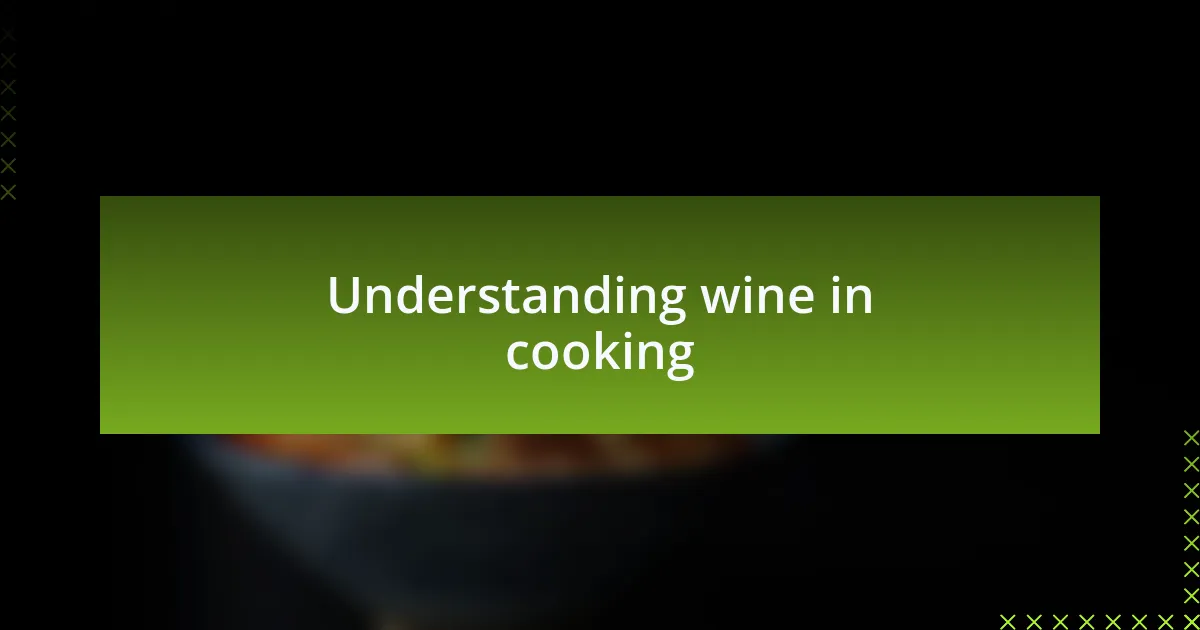
Understanding wine in cooking
Wine in cooking is not just an ingredient; it’s a transformative element that can elevate a dish from ordinary to extraordinary. I remember the first time I added a splash of red wine to a simple beef stew. The rich aroma that enveloped my kitchen was unforgettable, and the depth of flavor it brought to the dish was truly remarkable. Have you ever experienced that moment when a dish transcends your expectations? It’s often the subtle touch of wine that makes all the difference.
Understanding the different types of wine and how they interact with various ingredients is crucial. For instance, I love using a dry white wine in seafood dishes; it brightens the dish and complements the natural flavors beautifully, creating a perfect balance. People often wonder, should I cook with wine that I drink? My experience tells me that using a wine you enjoy sipping can provide a harmonious and cohesive flavor profile to your meal.
Furthermore, the technique of deglazing a pan with wine can unlock layers of flavor that you may not have thought possible. I vividly recall a dinner party where I used leftover Pinot Noir to deglaze a skillet after searing lamb. The caramelized bits infused the sauce with an earthy richness that left my guests raving about the meal. It’s moments like these that remind me of wine’s ability to bring not just flavors, but also memories and connections to the dining experience.
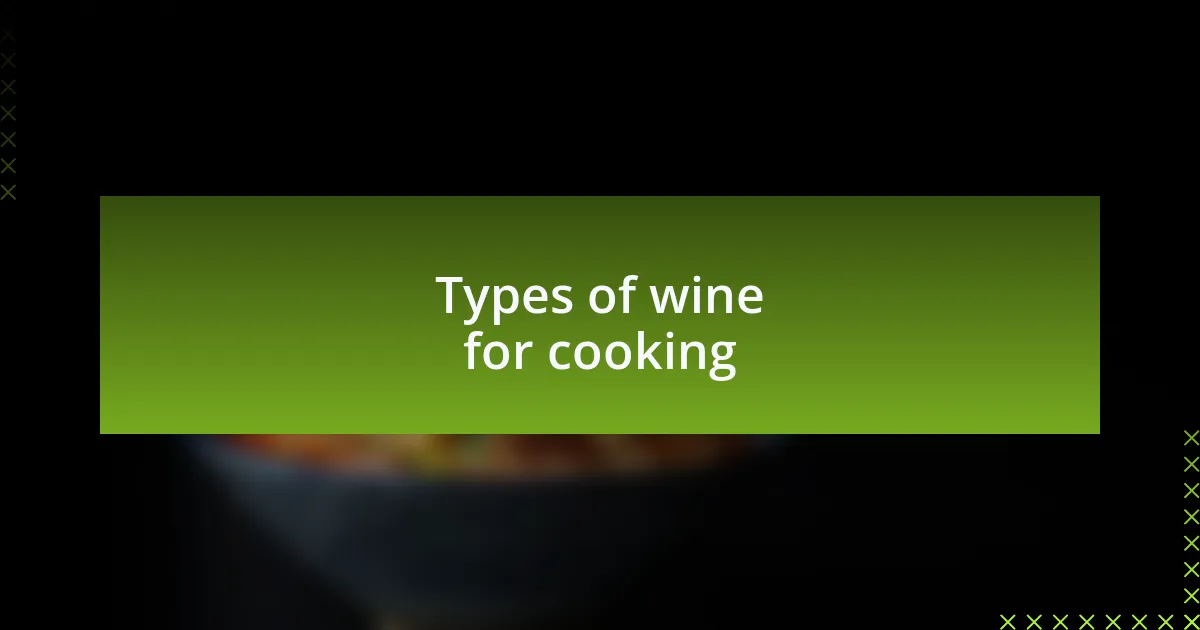
Types of wine for cooking
When it comes to cooking, two main types of wine come to mind: red and white. Red wines, such as Cabernet Sauvignon or Merlot, bring deep, robust flavors to hearty dishes like stews and marinades. I still recall an unforgettable pasta night where I incorporated a bold red wine into my sauce; it not only deepened the hue but also transformed the flavor profile into something delectable and unforgettable.
On the other hand, white wines like Sauvignon Blanc or Chardonnay can elevate lighter dishes, especially those featuring chicken or seafood. I often find that a splash of white wine in a creamy risotto enhances its richness while adding a fresh acidity. Have you ever noticed how a well-chosen wine can completely change the outcome of your dish? It’s a delightful reminder of how wine can harmonize with culinary creations.
Lastly, let’s not forget dessert wines, which can add a unique twist. Using something like a sweet late-harvest Riesling in a fruit compote provides an exquisite touch of sweetness. I once tried this in a simple galette, and the combination was sublime. Combining wines into your cooking repertoire opens up a world of flavors; what will you experiment with next?
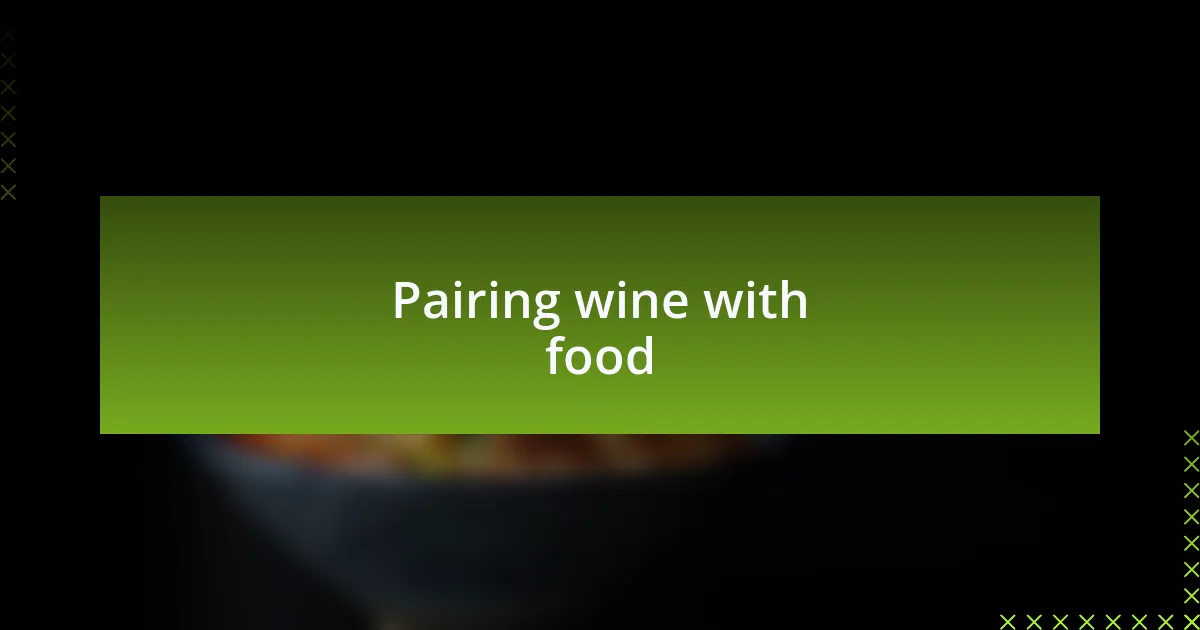
Pairing wine with food
Pairing wine with food is an art that can elevate a meal from good to exceptional. I fondly remember hosting a dinner party where I paired a Pinot Noir with a rich mushroom risotto. The earthiness of the wine complemented the dish so perfectly that guests were asking for the recipe and the wine choice long after the evening ended. Who knew that a thoughtful pairing could create such a memorable experience?
It’s fascinating how the synergy between wine and food can transform both elements. I often recommend matched body types; for instance, lighter white wines paired with delicate dishes can enhance their flavors without overpowering them. I once experimented with a crisp Sauvignon Blanc alongside grilled lemon-garlic shrimp, and the freshness of the wine brought out every nuance in the dish. Isn’t it amazing how a simple choice can unlock complex flavors?
When considering dessert, the right wine can make all the difference. I’ve enjoyed zinfandel with dark chocolate desserts, where the boldness of the wine coupled with the richness of chocolate created a harmonious balance. Have you ever felt the rush of flavors intertwining on your palate, leaving you eager for another bite? That’s the magic of wine pairing; it invites you to explore new dimensions of taste, making each meal an adventure.
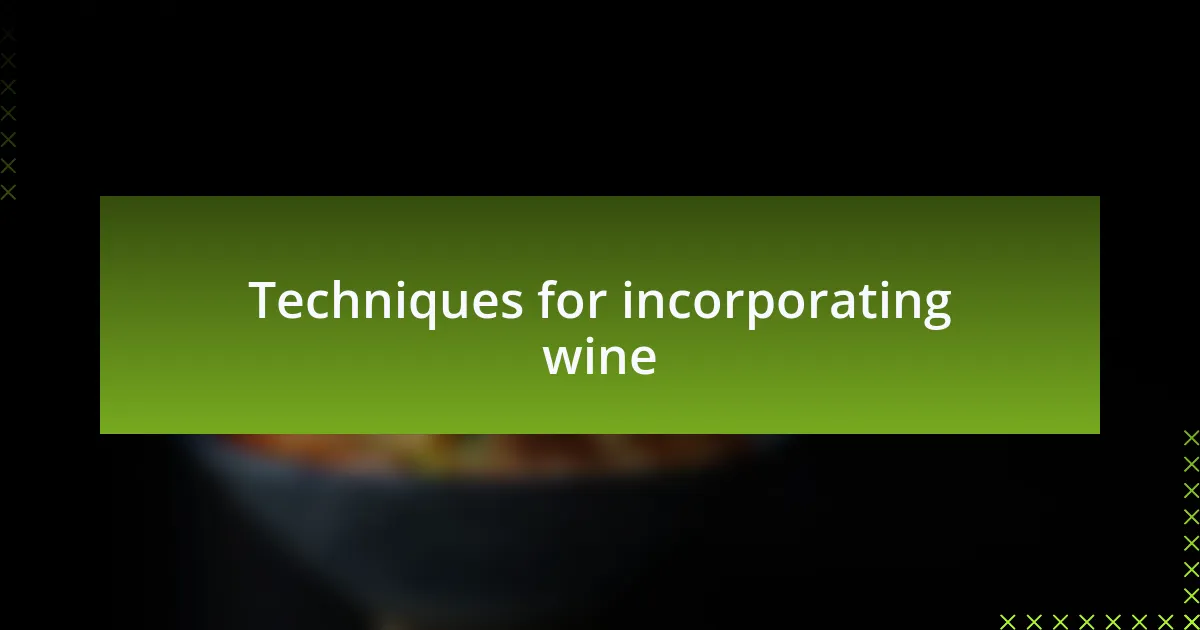
Techniques for incorporating wine
When I incorporate wine into my cooking, I often start by using it as a marinade. A lively Cabernet Sauvignon can add depth to a beef dish. I once marinated a flank steak in it, along with some herbs and garlic, and the result was a tender, flavorful masterpiece that had friends begging for the recipe.
Deglazing is another technique I love. After searing meat, I pour in a splash of wine to lift those caramelized bits from the pan. This creates a rich sauce that carries the essence of the dish. I still remember the first time I deglazed a pan with a fragrant Merlot after roasting chicken; it brought the whole meal to life in a way I hadn’t anticipated. Isn’t it incredible how a bit of liquid can transform a simple sauce?
Reducing wine for a sauce is a technique I swear by. I love the concentration of flavors that comes from simmering wine down until it thickens. I recall making a red wine reduction for a beef tenderloin, and the decadent sauce turned a wonderful dish into an unforgettable experience. Who knew that patience in the kitchen could yield such rich rewards?

Personal experiences with wine
When I first dipped my toes into the world of cooking with wine, I remember how intimidated I felt. On a rainy Sunday, I decided to try making a coq au vin, hoping that the famous dish would elevate my culinary skills. As I let the Pinot Noir infuse the chicken with an earthy richness, I couldn’t help but smile at how a single ingredient transformed the entire dish. The aroma filled the kitchen, wrapping around me like a warm embrace.
One evening, I hosted a small dinner party featuring a classic risotto, and I had a bottle of crisp white wine on hand. I decided to add a splash while cooking, not just for flavor, but to see if it would lighten the dish. The moment I stirred it in, I felt a sense of adventure. The wine brought a delightful brightness that danced on the palate, and by the end of the night, my guests were raving about the “secret ingredient.” Isn’t it magical how experimentation in the kitchen can turn ordinary meals into cherished memories?
Reflecting on those moments, I realize that wine is more than just a cooking ingredient; it’s a catalyst for creativity in the kitchen. Each time I open a bottle, I approach the experience with curiosity and hope. I once tried using a leftover rosé in a fruit compote, and the result was an unexpected burst of flavors. Have you ever tried integrating wine in a way you never thought possible? Those moments remind me that cooking is about exploration, and wine can be the key that unlocks new culinary adventures.
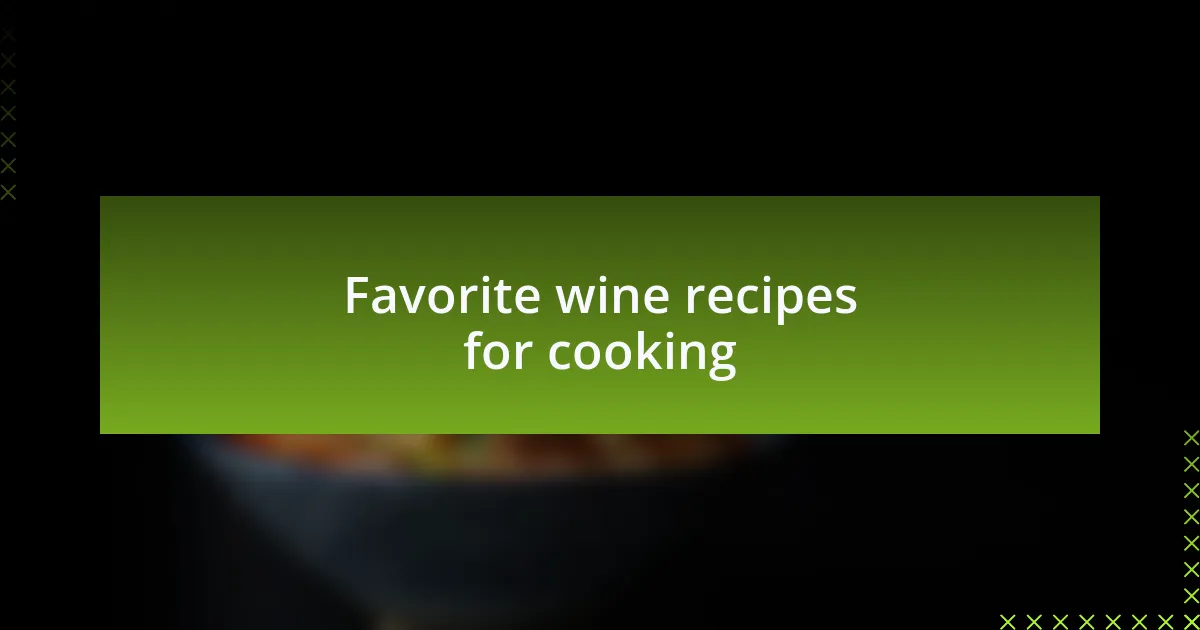
Favorite wine recipes for cooking
One of my all-time favorite recipes that highlight the beauty of wine in cooking is a hearty beef stew. I remember the first time I used a bold red wine to enhance the flavors. As I let the meat braise, the wine mingled with herbs and vegetables, creating a mouthwatering aroma that filled the house. The richness of the wine added depth, making each bite feel like a warm hug on a cold night. How often do you find comfort in a slow-cooked meal?
Another dish I love to prepare is a simple yet elegant chicken piccata. When I first tried adding white wine to the sauce, I was amazed at how it elevated the lemony zest. I can still picture the moment as the wine reduced, transforming into a luscious glaze and coating the chicken perfectly. Each forkful was a delightful balance of flavors, leaving me to wonder: can something as straightforward as a splash of wine truly elevate a dish that much?
Lastly, I’ve had great success with a delectable mussels dish simmered in white wine and garlic. It was during one leisurely weekend when I decided to pair my love for seafood with a dry white. The scent of garlic and fresh herbs dancing with the wine was intoxicating. The moment I served it, my friends couldn’t get enough! It made me think: how can something so simple create such joy around the table? Those are the culinary moments that fuel my passion for cooking with wine.